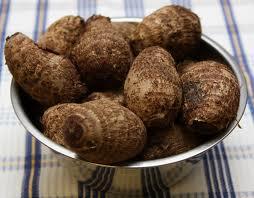
What they are?
Eddoes are circular root vegetable that bares resemblance to a yam or sweet potato. Originally a product of Asia, eddoes have found their way into multiple cuisines, such as Caribbean, Chinese and Indian.
Knowing the nutrient content of eddoes will better help you find a place for them in your diet. They are most commonly baked, boiled, fried and roasted.
Carbohydrate Content
Protein
Fat
Fiber
Calories and Sodium
Vitamins and Minerals
Root vegetables are notorious for being high in carbs, and eddoes are no exception. One cup of cooked eddoes contains 28 grams of carbs. This macronutrient helps boost energy levels and promotes brain function. The recommended daily intake of carbs for adults is 45 to 65 percent of total calories.
Protein is used for cell regeneration and muscle growth. In contrast to carbs, eddoes have a low amount of protein. Once cup contains only 2 grams. The daily recommended intake of this macronutrient is 46 grams a day for women 19 to 70 years old and 56 grams for men 19 to 70 years old.
Doctors advise people to watch their fat intake, especially saturated and trans fats. The daily recommendation for total fat is 25 to 35 percent of total calories. Saturated fat should be limited to 7 percent or less and trans fat should be kept under 1 percent. Eddoes have zero grams of saturated and trans fat.
Dietary fiber is beneficial and creates a feeling of fullness so you eat less. Fiber also helps keep cholesterol levels under control. Eddoes have a high fiber content. One cup of cooked eddoes contains 4 grams. Men 50 years of age or younger should aim for 38 grams of fiber per day, and men over 51 should get at least 30 grams. Women 50 years of age or younger should get 25 grams, and women over 51 should aim for 21 grams.
A high intake of sodium is known to cause water retention, which raises the risk for high blood pressure. When consumed in regulated amounts, sodium is beneficial to the body. The daily recommendation for this mineral is 2,400 milligrams, or 1,500 milligrams for people with high blood pressure. A cup of cooked eddoes contains only 11 milligrams of sodium. The calories in an eddoe are similar to a regular yam. One cup contains just over 115 calories. Most of these calories come from carbs, which have 4 calories per gram.
Eddoes contain small amounts of several vitamins and minerals. A 1-cup serving has 8 percent of the recommended daily intake of vitamin C, 4 percent of calcium, 2 percent of vitamin A and 3 percent of iron. The recommended daily intake for vitamin C is 75 milligrams for women 19 years and older, and 90 milligrams for men in this same age group. Adults 19 to 50 years old should get 1,000 milligrams of calcium a day. However, women over 50 should up this amount to 1,200 milligrams. Males aged 14 and older should get 900 micrograms of vitamin A, and females in this age group should get 700 micrograms per day. Lastly, both men and women should get at least 15 milligrams of iron daily.





